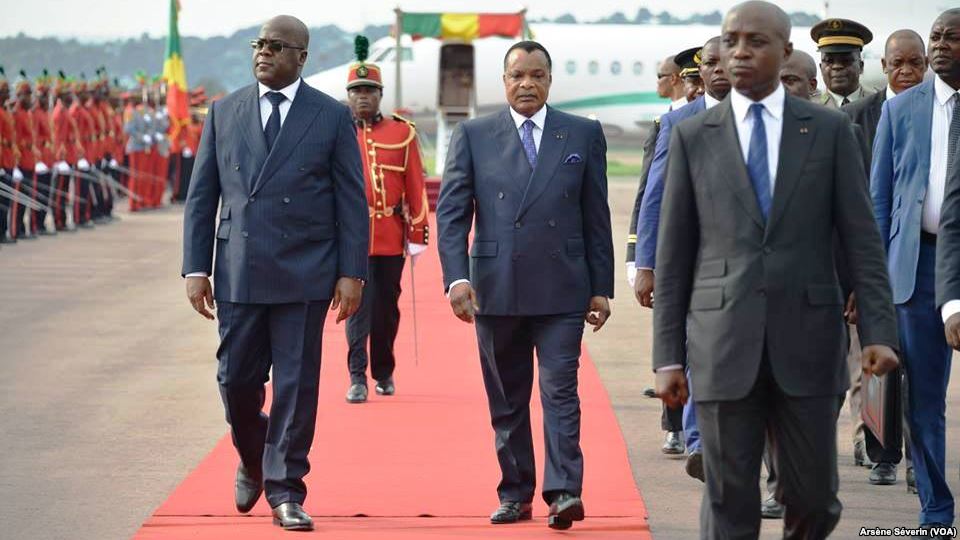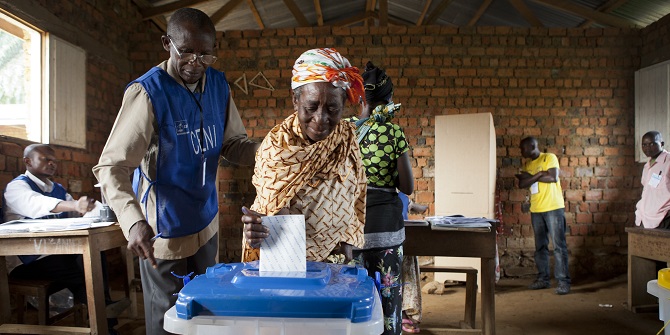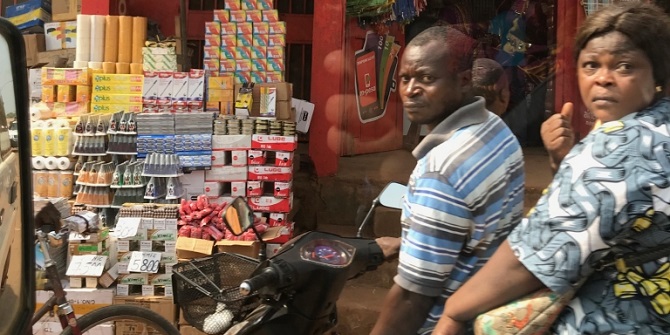
Since his coming to power in January 2019, restoring peace and security, particularly in the conflict-ridden Eastern provinces, has been one of President Félix Tshisekedi’s main promises. While not clearly or publicly expressed, President Tshisekedi and his key advisors have established a multi-faceted security strategy. A key condition to any successful security response though was the consolidation of the President’s legitimacy and authority, which indeed was initially very fragile, given that Tshisekedi was installed after a flawed electoral process. In order to get the necessary regional and international recognition as Congo’s Head of State, the President first invested in an increased diplomacy. This diplomacy also envisaged an enhanced regional political and security co-operation. This cooperation soon became a key component of his security strategy, which indeed seemed a logic step given the deep connections between security conditions in the DRC and political dynamics in neighbouring countries. A second key component included the mobilisation of the Congolese military, which is largely perceived as beholden to his predecessor, Joseph Kabila, and thus escaping control from the new regime. This had to result in the development of a combined approach of maintaining military operations to fragilise armed groups, while supporting demobilisation efforts. A reinforcement of the relationship with the UN peacekeeping mission MONUSCO had to provide the necessary support.
Rebuilding international legitimacy
One year later, some of the challenges and inherent limitations of this ambition have become visible. President Tshisekedi has been very successful in gaining international legitimacy. Since his inauguration, he visited about thirty countries around the world. He attended several African Union (AU) summits, the UN General Assembly and other high-level meetings and had numerous bilateral meetings with regional and international heads of state. As a result, the DRC has reclaimed much of the lost ground in the region and on the international scene, and the Congolese regime is no longer considered a pariah. Beyond attracting international investment and restoring relations with major donors and the international financial institutions, he could attract renewed interest in dealing with the security situation in the DRC. At the domestic level the picture is more mitigated. The institutional balance of power is still tilted heavily in favor of his predecessor Joseph Kabila, whose political, economic and military control networks seem to have remained largely intact. Furthermore, the DRC’s financial situation leaves little margin for ambitious policy initiatives and reform. This is likely to be worsened by the global impact of the COVID-19 pandemic. Tshisekedi’s own political alliance with Vital Kamerhe, his chief of staff, has become more complex since Kamerhe’s arrest on 8 April 2020, which might considerably affect his domestic support base. In the east, the efforts to reduce the number of armed groups are presenting new challenges and risk reshuffling the security landscape.
Neighbourhood alliances
Moving beyond the initial needs of building legitimacy, an intensive regional and bilateral diplomacy became one of the key instruments to respond to DRC’s security concerns. At the 32nd AU summit in February 2019, Tshisekedi called for a need to consolidate peace and security in the DRC through joint strategies with the country’s direct neighbours. What followed was a flurry of bilateral meetings and sub-regional summits. The main result thus far has been the joint initiative with Angolan President Joao Lourenço, establishing a quadripartite mechanism between the DRC, Rwanda, Uganda and Angola. A memorandum of understanding was signed by the Rwandan and Ugandan presidents promising not to use Congolese territory to destabilise other countries in the region, and to pacify and normalise the relationship between both countries. Several follow-up meetings have since been held, and existing tensions between Presidents Kagame and Museveni do not seem to have intensified despite limited effective progress. President Tshisekedi also solicited support from the Southern African Development Community (SADC), which at its summit in August 2019 agreed to collaborate with the International Conference of the Great Lakes Region (ICGLR) and to consolidate efforts towards security stabilisation in the DRC and the Great Lakes Region. With the facilitators of the Peace, Security and Cooperation Framework (PSCF) for the DRC and the Great Lakes Region, which include the UN, the AU, the ICGLR and SADC, enhanced cooperation between intelligence services of the region was initiated. Regular meetings are now being held between chiefs of intelligence and security services from Burundi, Uganda, the DRC, Rwanda, and Tanzania. An agreement was also concluded on ‘coordinated and concerted regional action’ against armed groups active in eastern DRC. In this framework, Félix Tshisekedi also supported the creation of an integrated general staff of the region’s armies (Burundi, Rwanda, Uganda and Tanzania and one of MONUSCO’s Integrated Force Brigade contingents), which is tasked with facilitating joint strategies and military operations.
Besides these regional initiatives, President Tshisekedi’s security initiatives also build on direct arrangements with Congo’s eastern neighbours. With Uganda, bilateral meetings between Tshisekedi and Museveni mainly dealt with the Allied Democratic Forces (ADF), an armed group having its origins in Uganda and being accused of having killed thousands of civilians in the Beni region (North Kivu). Similar talks with Rwandan President Kagame incited renewed military cooperation and joint operations against the National Council for Democratic Renewal (CNRD), an-FDLR split-off group and currently the main Rwandan opposition group operating in the Kivu provinces. And with his Burundian counterpart Pierre Nkurunziza, the Congolese president agreed to deal with the presence of Congolese and Burundian armed groups in the border area of the Ruzizi Plains (South Kivu).
While engaging regional leaders in processes to bring an end to the violence and the conflict economy is laudable and a necessary first step, the pursued interests may be fundamentally divergent. Despite the focus on this intense regional diplomacy, it is increasingly clear that even with Angolan support, the DRC cannot overcome existing rivalries between regional leaders that in the course of the past decades have profited from intricate networks of predation established in eastern DRC.
President Tshisekedi’s search for regional alliances was also met with increased skepticism and mistrust at the domestic level. This is in particular the case for the intensified collaboration with Rwanda, still largely considered by many Congolese as an enemy. It revived the widespread anti-Rwandan and anti-Tutsi sentiments despite some successful operations against the CNRD, a key source of insecurity for Congolese. In response to this collaboration, the head of the Congolese Catholic Church, Cardinal Ambongo and former Presidential Candidate Martin Fayulu earlier this year declared that President Tshisekedi contributed to a Balkanisation of Congo’s territory, a process which Fayulu argued was initiated by former President Joseph Kabila and was now reaching its conclusion. Such declarations gained massive popular support, and provoked several armed groups to reposition themselves, negating some of the progress that had been achieved in demobilisation and thus further complicating Tshisekedi’s internal security agenda.
The military: a help or hindrance to stabilisation?
Another issue limiting Tshisekedi’s space to maneuver is that former President Kabila’s structure of control over the army seems to remain largely intact. In addition, the record of military operations against armed groups highlight the continued level of disorganisation of the army’s command and the ineffectiveness of its actions. Rather than having reduced the operational space of armed groups, military actions so far have mainly redrawn their geography without dismantling them. And in cases where armed groups are ready to demobilise, the army is trying to keep control over the process. Without the necessary reintegration mechanisms in place and without improving local conditions, this opportunity has largely been missed as numerous disappointed and demobilised combatants are now returning to combat.
Continued military operations against armed groups are an important factor in the push for demobilisation. And such operations have continued under President Tshisekedi, most prominently against the ADF in North Kivu. In November, following a new spat of attacks on civilians for which mainly the ADF is held responsible and which augmented civilian anger against MONUSCO, President Tshisekedi decided to install an advanced headquarters of the Congolese army in Beni. This had to coordinate joint military operations with the Congolese forces and MONUSCO. While these operations were initially successful, they subsequently disrupted existing balances and complicated the security situation even further in the operational area.
In addition to the lack of concrete progress in addressing the situation in the East, new areas of conflict further complicate the picture. In the former Katanga province, tensions between ‘Katangese’ and ‘Kasaian’ communities have been rising, most recently in the wake of the 28 March incidents following the escape of Mai Mai leader Gédéon. The current tension in Katanga, the countries’ economic heartland, has direct ties to the tense political stand-off between President Tshisekedi and his predecessor, supported by his predominantly Katangese economic and security networks.
Supporting DDR efforts and regional initiatives
In other words, if President Tshisekedi wants to meet his ambition to restore peace and stability in the DRC, there is still a long way to go, particularly as new challenges are arising and the international community’s focus on the DRC risks to disappear again because of other priorities. A key and perhaps most challenging condition to a successful stabilisation strategy remains the existence of an accountable and reliable military. This requires an internationally supported reform process, including a clean-up of the command structures and a replacement of the close-knit networks of the former regime. A second key factor is the development of a new and integrated demobilisation and reintegration approach of combatants that takes into account the lessons learnt from earlier attempts. Community-based approaches which are now being promoted by different donors, can only succeed when the necessary local structures are in place. This is not the case today, which explains the constant and circular return of former demobilised combatants. Military responses can also only be in support of a larger political strategy aiming for peace and security in the most conflict-affected part of the DRC. Such strategy again needs to be inclusive and cannot succeed without tackling existing logics of militarised politics. Finally, a potential success of Tshisekedi’s security policy also depends on regional efforts.
The primacy should remain on managing and reducing the tension between regional leaders, in particular Rwanda and Uganda through the quadripartite initiative. Where possible South Africa, the AU, SADC and close allies of Tshisekedi such as Kenya should be included in this predominantly Africa-led process. While in today’s context a sub-regional military coalition would add to the complexity of the situation on the ground and increase risk for further escalation rather than reducing it, an increased exchange and collaboration between regional militaries will certainly contribute to the accountability of regional states. It should, in such contexts, increase transparency to the ad-hoc and overt military operations by neighbouring states in the DRC and should bring to an end the enduring covert activities. Congo’s main international partners, the US, the EU (and several of its member states), the UK and China should act in support of such regional diplomatic initiatives while also providing support to the reform of the Congolese security forces. In view of its future exit, MONUSCO should increasingly focus on enabling and supporting such reform in addition to the provision of its support to DDR and regional initiatives.
Note: The CRP blogs gives the views of the author, not the position of the Conflict Research Programme, the London School of Economics and Political Science, or the UK Government.






RIEN SUR LA DYNAMIQUE AVEC ISRAEL ET LES USA….